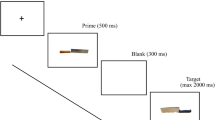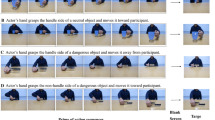Abstract
A variety of studies showed that participants are facilitated when responding to graspable objects, while it has not been fully investigated what happens during interactions with graspable objects that are potentially dangerous. The present study focuses on the mechanisms underlying the processing of dangerous objects. In two experiments, we adopted a paradigm that has never been employed in this context, a bisection task. The line was flanked by objects belonging to different categories. We explored the sensitivity to the distinction between neutral and dangerous objects, by measuring whether the performance was biased toward a specific object category. In Experiment 1 both teenagers and adults bisected lines flanked by dangerous and neutral graspable objects, and they misperceived the line midpoint toward the neutral graspable object or, stated differently, on the opposite side of the dangerous graspable object. In Experiment 2 adults bisected lines flanked by dangerous and neutral objects matched on graspability (both graspable and ungraspable, Experiment 2a), or by graspable and ungraspable objects matched on dangerousness (both neutral and dangerous, Experiment 2b). Results confirmed the finding of Experiment 1, but also indicated that participants misperceived the line midpoint toward the ungraspable object when it was presented, being it dangerous or not. This evidence demonstrated sensitivity to object dangerousness maintained across lifespan. The emergence of aversive affordances evoked by dangerous graspable objects strenghtens the importance to consider graspability in the investigation of dangerous objects. Possible neural mechanisms involved in the processing of dangerous graspable objects are discussed.



Similar content being viewed by others
References
Anelli F, Nicoletti R, Borghi AM (2010) Categorization and action: what about object consistence? Acta Psychol 133:203–211
Anelli F, Borghi AM, Nicoletti R (2012a) Grasping the pain: motor resonance with dangerous affordances. Conscious Cogn 21:1627–1639. doi:10.1016/j.concog.2012.09.001
Anelli F, Nicoletti R, Kalkan S, Sahin E, Borghi AM (2012b) Human and robotics hand grasping danger. In: Proceedings of the International Joint Conference on Neural Networks (IJCNN) pp 1613–1620
Avenanti A, Bueti D, Galati G, Aglioti SM (2005) Transcranial magnetic stimulation highlights the sensorimotor side of empathy for pain. Nat Neurosci 8:955–960
Avenanti A, Minio-Paluello I, Bufalari I, Aglioti SM (2006) Stimulus-driven modulation of motor-evoked potentials during observation of others’ pain. NeuroImage 32:316–324
Avenanti A, Sirigu A, Aglioti SM (2010) Racial bias reduces empathic sensorimotor resonance with other-race pain. Curr Biol 20:1018–1022
Barton JJ, Behrmann M, Black S (1998) Ocular search during line bisection: the effects of hemi-neglect and hemianopia. Brain 121:1117–1131
Bisiach E, Capitani E, Colombo A, Spinnler H (1976) Having a horizontal segment: a study on hemisphere-damaged patients with cerebral focal lesions. Schweiz Arch Neurol 118:199–206
Blanchette I (2006) Snakes, spiders, guns, and syringes: how specific are evolutionary constraints on the detection of threatening stimuli? Quart J Exp Psyc 59(8):1484–1504
Borghi AM, Flumini A, Natraj N, Wheaton LA (2012) One hand, two objects: emergence of affordance in contexts. Brain Cogn 80(1):64–73
Bub DN, Masson MEJ (2010) Grasping beer mugs: on the dynamics of alignment effects induced by handled objects. J Exp Psychol Hum Percept Perform 36:341–358
Castiello U (2003) Understanding other people’s actions: intention and attention. J Exp Psychol Hum Percept Perform 29:416–430
Chao LL, Martin A (2000) Representation of manipulable man-made objects in the dorsal stream. Neuroimage 12:478–494
Coello Y, Bourgeois J, Iachini T (2012) Embodied perception of reachable space: how do we manage threatening objects? Cogn Process 13(Suppl 1):131–135
Craighero L, Fadiga L, Rizzolatti G, Umiltà CA (1998) Visuomotor priming. Vis Cogn 5:109–125
Craighero L, Fadiga L, Rizzolatti G, Umiltà CA (1999) Action for perception: a motor-visual attentional effect. J Exp Psychol Hum Percept Perform 25:1673–1692
Creem-Regehr SH, Lee JN (2005) Neural representations of graspable objects: are tools special? Cogn Brain Res 22:457–469
Dolan RJ (2002) Emotion, cognition, and behaviour. Science 298:1191–1194
Edwards MG, Humphreys GW, Castiello U (2003) Motor facilitation following action observation: a behavioural study in prehensile action. Brain Cognition 53:495–502
Ellis R, Tucker M (2000) Micro-affordance: the potentiation of components of action by seen objects. Brit J Psychol 91:451–471
Fagioli S, Hommel B, Schubotz RI (2007) Intentional control of attention: action planning primes action-related stimulus dimensions. Psychol Res 71:22–29
Fischer MH (2001) Cognition in the line bisection task. Trends Cogn Sci 5:460–462
Fischer HM, Prinz J, Lotz K (2008) Grasp cueing shows obligatory attention to action goals. Q J Exp Psychol 61:860–868
Gerlach C, Law I, Paulson OB (2002) When action turns into words. Activation of motor-based knowledge during categorization of manipulable objects. J Cognitive Neurosci 14:1230–1239
Gibson JJ (1979) The ecological approach to visual perception. Houghton Mifflin, Boston
Goslin J, Dixon T, Fischer MH, Cangelosi A, Ellis R (2012) Electrophysiological examination of embodiment in vision and action. Psychol Sci 23(2):152–157
Grafton ST, Fadiga L, Arbib MA, Rizzolatti G (1997) Premotor cortex activation during observation and naming of familiar tools. NeuroImage 6:231–236
Jewell G, McCourt ME (2000) Pseudoneglect: a review and meta-analysis of performance factors in line bisection tasks. Neuropsychologia 38:93–110
Johnson-Frey SH (2004) The neural bases of complex tool use in humans. Trends Cogn Sci 8:71–78
Kerkhoff G, Bucher L (2008) Line bisection as an early method to assess homonymous hemianopia. Cortex 44:200–205
Martin A (2007) The representation of object concepts in the brain. Ann Rev Psychol 58:25–45
Morrison I, Peelen MP, Downing P (2007a) The sight of others’ pain modulates motor processing in human cingulated cortex. Cereb Cortex 17:2214–2222
Morrison I, Poliakov E, Gordon L, Downing P (2007b) Response-specific effects of pain observation on motor behavior. Cognition 104:407–416
Öhman A, Flykt A, Esteves F (2001) Emotion drives attention: detecting the snake in the grass. J Exp Psychol Gen 130(3):466–478
Ranzini M, Girelli L (2012) Exploiting illusory effects to disclose similarities in numerical and luminance processing. Atten Percept Psychophys 74(5):1001–1008
Ranzini M, Borghi AM, Nicoletti R (2011a) With hands I do not centre! Action- and object-related effects of hand-cueing in the line bisection. Neuropsychologia 49:2918–2928
Ranzini M, Lugli L, Anelli M, Carbone R, Nicoletti R, Borghi AM (2011b) Graspable objects shape number processing. Front Hum Neurosci 5:147
Raos V, Umiltà MA, Murata A, Fogassi L, Gallese V (1996) Functional properties of grasping-related neurons in the ventral premotor area F5 of the macaque monkey. J Neurophysiol 95(2):709–729
Rizzolatti G, Craighero L (2004) The mirror-neuron system. Ann Rev Neurosci 27:169–192
Schenkenberg T, Bradford DC, Ajax ET (1980) Line bisection and unilateral visual neglect in patients with neurologic impairment. Neurology 30:509–517
Singer T, Seymour B, O’Doherty J, Kaube H, Dolan RJ, Frith CD (2004) Empathy for pain involves the affective but not sensory components of pain. Science 303:1157–1162
Symes E, Tucker M, Ellis R, Vainio L, Ottoboni G (2008) Grasp preparation improves change detection for congruent objects. J Exp Psychol Hum Percept Perform 34:854–871
Symes E, Ottoboni G, Tucker M, Ellis R, Tessari A (2010) When motor attention improves selective attention: the dissociating role of saliency. Q J Exp Psychol 63:1387–1397
Toba M-N, Cavanagh P, Bartolomeo P (2011) Attention biases the perceived midpoint of horizontal lines. Neuropsychologia 49(2):238–246
Tucker M, Ellis R (1998) On the relations between seen objects and components of potential actions. J Exp Psychol Hum Percept Perform 24:830–846
Tucker M, Ellis R (2001) The potentiation of grasp types during visual object categorization. Visual Cogn 8:769–800
Tucker M, Ellis R (2004) Action priming by briefly presented objects. Acta Psychol 116:185–203
Acknowledgments
This work was supported by grant from MIUR (PRIN 2008) and by the European Community, in FP7 project ROSSI: Emergence of Communication in RObots through Sensorimotor and Social Interaction (Grant agreement no: 216125). Part of this work was carried on with the support of the Marino Golinelli Foundation (Bologna, Italy). The authors thank Carlo Toneatto and Luisa Girelli (University of Milano-Bicocca, Italy) for a preliminary version of the task; EMCOlab group (www.emco.unibo.it) for helpful comments.
Author information
Authors and Affiliations
Corresponding author
Rights and permissions
About this article
Cite this article
Anelli, F., Ranzini, M., Nicoletti, R. et al. Perceiving object dangerousness: an escape from pain?. Exp Brain Res 228, 457–466 (2013). https://doi.org/10.1007/s00221-013-3577-2
Received:
Accepted:
Published:
Issue Date:
DOI: https://doi.org/10.1007/s00221-013-3577-2




